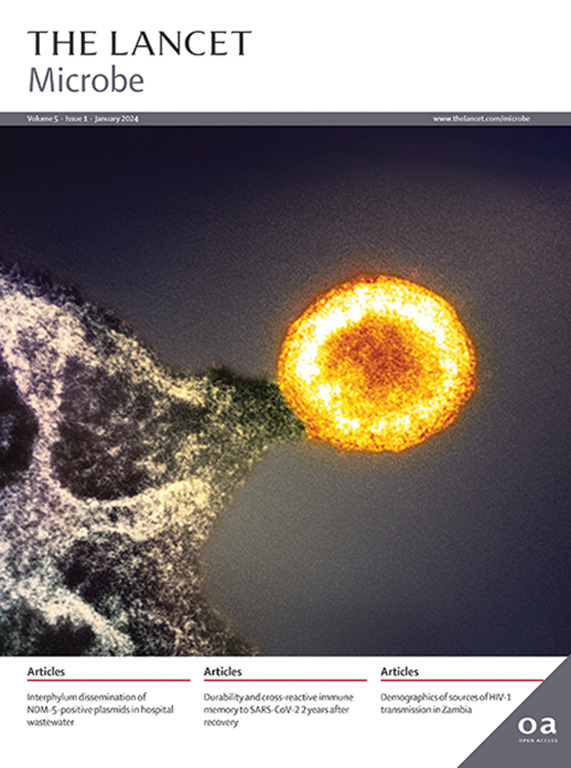COVID-19 大流行限制后肺炎支原体重新出现的全球时空动态:流行病学和传播模型研究。
IF 20.9
1区 生物学
Q1 INFECTIOUS DISEASES
引用次数: 0
摘要
背景:肺炎支原体是呼吸道感染的主要病原体。我们的目的是调查在针对 COVID-19 实施非药物干预措施(NPIs)后,肺炎支原体感染的时空动态、抗菌药耐药性和延迟复发的严重程度:从 2017 年 4 月 1 日至 2024 年 3 月 31 日,我们通过全球监测收集了流行病学数据(阳性检测数和总检测数,以及耐大环内酯类药物的肺炎双球菌检测数)和临床数据(住院人数、重症监护室 [ICU] 入院人数和死亡人数)。我们使用移动流行病学方法(MEM)来确定流行期,并使用时间序列易感-感染-恢复(TSIR)模型来研究延迟再流行:数据集包括联合国四个地区 29 个国家的 65 个地点:研究结果:数据集包括联合国四个地区(欧洲、亚洲、美洲和大洋洲)29 个国家的 65 个地点。通过 PCR 检测发现,从 2023 年下半年开始,全球再次出现肺炎 M 型菌病例。在病例重新出现期间(2023 年 4 月至 2024 年 3 月),全球平均检出率为 11-47%(SD 15-82)。通过使用 MEM,在第 40 个日历周(2023 年 10 月初),联合国所有四个地区同时有 10 个国家被确定为流行病再次爆发。欧洲和亚洲对大环内酯类药物耐药的 M 型肺炎球菌的比例分别为 2-02% 和 71-22%,在再次流行期和前 COVID-19 大流行期之间没有差异。在大流行再次爆发期间,一些国家报告住院人数增加(10 个国家中的 2 个国家报告成人住院人数增加;14 个国家中的 2 个国家报告儿童住院人数增加),重症监护室收治人数增加(9 个国家中的 1 个国家报告成人住院人数增加;14 个国家中的 2 个国家报告儿童住院人数增加)。总体而言,报告的死亡人数为 65 例(0-11%),COVID-19 大流行前与再次出现大流行之间没有统计学差异。考虑到肺炎 M 型杆菌的产生时间为 3 周,通过非感染性传染病的传播率降低了 90%,TSIR 模型准确预测了所观察到的延迟再流行现象:这一大规模的全球肺炎 M 型菌检测数据集显示,尽管 2023 年末许多国家的肺炎 M 型菌检测数量达到了前所未有的高水平,但严重程度和死亡人数仍然很低。我们的研究结果表明,肺炎霉菌感染的延迟再次出现与肺炎霉菌感染的潜伏期较长有关:无。本文章由计算机程序翻译,如有差异,请以英文原文为准。
Global spatiotemporal dynamics of Mycoplasma pneumoniae re-emergence after COVID-19 pandemic restrictions: an epidemiological and transmission modelling study
Background
Mycoplasma pneumoniae is a major cause of respiratory tract infections. We aimed to investigate the spatiotemporal dynamics, antimicrobial resistance, and severity of the delayed re-emergence of infections with M pneumoniae after the implementation of non-pharmaceutical interventions (NPIs) against COVID-19.
Methods
Epidemiological data (positive and total test numbers, and macrolide-resistant M pneumoniae detections) and clinical data (hospitalisations, intensive care unit [ICU] admissions, and deaths) were collected through our global surveillance from April 1, 2017 to March 31, 2024. The moving epidemic method (MEM) was used to establish epidemic periods, and the time-series susceptible–infected–recovered (TSIR) model to investigate the delayed re-emergence.
Findings
The dataset included 65 sites in 29 countries from four UN regions: Europe, Asia, the Americas, and Oceania. A global re-emergence of M pneumoniae cases by PCR detection was noted from the second half of 2023. The mean global detection rate was 11·47% (SD 15·82) during the re-emergence (April, 2023–March, 2024). By use of MEM, the re-emergence was identified as epidemic in all four UN regions, simultaneously in ten countries at calendar week 40 (early October, 2023). Macrolide-resistant M pneumoniae rates from Europe and Asia were 2·02% and 71·22%, respectively, and did not differ between the re-emergence and pre-COVID-19 pandemic periods. During the re-emergence, some countries reported increased hospitalisations (in adults, two of ten countries; and in children, two of 14 countries) and ICU admissions (in adults, one of nine countries; and in children, two of 14 countries). Overall, 65 (0·11%) deaths were reported, without statistical difference between pre-COVID-19 pandemic and re-emergence. The TSIR model accurately predicted, considering a 3-week generation time of M pneumoniae and a 90% reduction in transmission through NPIs, the observed delayed re-emergence.
Interpretation
This large global dataset for M pneumoniae detections shows that although there was an unprecedented high number of detections across many countries in late 2023, the severity and number of deaths remained low. Our results suggest that the delayed re-emergence was related to the long incubation period of M pneumoniae infection.
Funding
None.
求助全文
通过发布文献求助,成功后即可免费获取论文全文。
去求助
来源期刊

Lancet Microbe
Multiple-
CiteScore
27.20
自引率
0.80%
发文量
278
审稿时长
6 weeks
期刊介绍:
The Lancet Microbe is a gold open access journal committed to publishing content relevant to clinical microbiologists worldwide, with a focus on studies that advance clinical understanding, challenge the status quo, and advocate change in health policy.
 求助内容:
求助内容: 应助结果提醒方式:
应助结果提醒方式:


